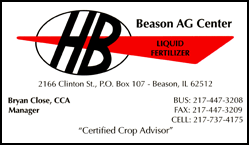|
 In order to effectively determine how warm the ground is, soil
temperatures are taken at depths of 4 inches and 8 inches. The
Illinois State Water Survey's Water and Atmospheric Resources
Monitoring program, or WARM, releases the resulting data hourly
every day on the WARM website. In order to effectively determine how warm the ground is, soil
temperatures are taken at depths of 4 inches and 8 inches. The
Illinois State Water Survey's Water and Atmospheric Resources
Monitoring program, or WARM, releases the resulting data hourly
every day on the WARM website.
According to WARM data taken from November 2011 through January
2012:
-
The median 4-inch soil temperature for the state of Illinois
was 38.0 degrees. This is 4.7 degrees higher than in the same
period last year.
-
The median 4-inch soil temperature in central Illinois it was
36.7 degrees, also higher than last winter.
By March 4, the soil temperature in Logan County approached
nearly 40 degrees, with that number expected to only continue to
climb. As a result, the anticipation is that farmers in Logan
County may decide to plant their crops a little early this year.

"It depends on the temperature and how much rain we get," said
Mark Luken, a farmer and employee at Lincoln Ag Center.
Typically, the planting of crops occurs in Logan County in
April, between the 10th and the 13th of the month. Corn, for
example, requires a temperature of 50 degrees to grow properly,
and the average April weather is optimal for such planting.
"But under warmer conditions, there may be farmers planting corn
in the first week of April," says Luken.
Planting early may allow for a greater potential yield of crops,
but taking advantage of the warmer soil comes with its own risks
as well.
If Logan County is hit with a large amount of rain early in the
spring, the presence of standing water may present problems. If
the soil is overly saturated, germinated seeds may not get
enough oxygen to continue growing. Furthermore, if the water is
the result of melting snow from a sudden cold snap, the seeds
may die due to chilling injury.

If enough water is present, it may even affect the fertilizers
and pesticides that are applied to crops when they are planted.
Too much rain could wash leached fertilizer. Fertilizer being
washed away is not as potentially devastating as the removal of
pesticides, however.
The warm winter is expected to bring an early return of insects
and other pests.
"Warmer temperatures could possibly result in greater insect
pressure on the crops," says Luken.
The number of pests that could be seen this spring will already
be higher than normal, as the cold temperatures that drive pests
underground or away from the area have not been as prevalent.
The same as with fertilizer, if the pesticides and herbicides
are washed away, the crops will be in greater danger of damage.
[to top of second column] |

Weeds will also present a potential problem, as the mild
temperatures have allowed for winter annuals to emerge from
dormancy. The weeds have a head start on growing, and removing
them could delay the planting of crops. The application of an
early burndown while weeds are small enough to be controlled by
herbicides is important.
The mild temperatures have also allowed for mold and fungi to
survive on remaining crop residue. Farmers will have to take
time to ensure that leftover plant material is properly tilled
and rotated; otherwise, diseases like frogeye leaf spot and
brown spot (on soybeans), or gray leaf spot and northern corn
leaf blight (on corn) could spread to new crops.
Taking advantage of the weather and planting early could be an
advantage, but such a practice is not entirely without risks.
Depending on the temperature and rain accumulations as spring
arrives this year, the farmers of Logan County might have a
challenge on their hands.
[Derek Hurley]
Resources:
The Illinois State Water Survey's Water and Atmospheric
Resources Monitoring program, known as WARM, collects hourly and
daily weather and soil information at 19 stations across the
state.

Daily and monthly summaries can be found on the WARM website,
http://www.isws.illinois.edu/warm/ and in the Illinois
Water and Climate Summary,
http://www.isws.illinois.edu/warm/climate.asp Hourly
data can be obtained by contacting Jennie Atkins,
jatkins@illinois.edu
This is one of the articles you will find in our special Spring
2012 Farm Outlook Magazine.
The magazine is online now.
Click here to view all the articles, which include:
Introduction by John Fulton
Weather: The biggest variable
2011 crop yields
Productivity: Corn-on-corn
Alternative income
Protecting your income with insurance
The value of land conservation
Property taxes on farmland
Land value in Logan County
Increasing yield with aerial application
The importance of Ag Scholarships
 |